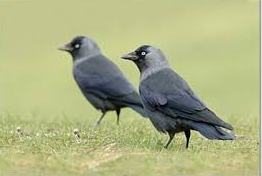 The Jackdaw (Corvus monedula also Coloeus pica) is just about the smallest corvids: 34-39 cm long, 250 grams with a wingspan of about 72 cm.
The Jackdaw (Corvus monedula also Coloeus pica) is just about the smallest corvids: 34-39 cm long, 250 grams with a wingspan of about 72 cm.
Typical is the gray color of the side neck and the back, and the light - gray to white eye ring. They see twice as good as humans. Almost entirely black specimens also occur sometimes. The relatively small beak is solid and dark, as well as the legs. He walks, in contrast to most other crows, fast and shocking.
The call is kjack, kjack, like their name. Researchers have found that jackdaws use a kind of language, with certain sounds for different situations. They are intelligent animals. They used to be kept as pets. The jackdaw can understand words, and speak a few recognizable words. They can be very old.
Jackdaws usually come in groups or pairs and often forage together. They exhibit brutal behavior. They have a very extensive menu: small invertebrates (such as insects, snails and spiders), seeds, grains, eggs and fruit. They easily find food near people: waste, cat food, carcasses of run over animals, compost heaps and chicken coops.
Jackdaws dare pull out and eat newly planted or germinating grains. They know that there is a fine grain in the soil. Scarecrows help temporarily. To combat groups permission should be sought.
Jackdaws exhibit active food sharing among peers, even more extensive than in chimpanzees. This is probably related to their social interaction and position.
They usually nest in trees in groups and have a fondness for old buildings and chimneys. They throw twigs, fabric, plastic and other debris in the chimney until it almost reaches to the opening. The stack of combustible material may be so meters high.
Place preventive firmly attached lattice or chicken wire (max. to 3x3 cm) over the opening. Or do it when the young late June have left the chimney. The birds and their eggs, nests and young are protected.
Couples remain lovers for life. The 4-5 eggs are incubated for 16-17 days and the young fly after about 30-35 days.
